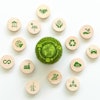Nature has provided the food industry with the perfect packages to imitate in the drive to embrace a new genre of boxes, bottles, fast-food clam shells and other sustainable packaging material for the 21st century.
Speaking at the 246th National Meeting & Exposition of the American Chemical Society (ACS) in September, Sara Risch, Ph.D., said that new packaging materials must meet the criteria for being sustainable without sacrificing the security, freshness and visibility of the food inside.
“We face a huge challenge in developing new packaging materials that protect food all through the supply chain while being recyclable, compostable, produced with renewable energy or even edible,” Risch explained. Nature has set the standard, and it is daunting. Apples, oranges, bananas, nuts—all come in packaging that is edible or compostable.
Risch said that the food industry clearly is embracing sustainable packaging. Although definitions vary, sustainable packaging often means packaging that can be composted, recycled or reused and is produced, transported and recycled using renewable energy; made with renewable or recycled materials; made in ways that optimize use of energy; and safe for people and the environment throughout its life cycle.
“The industry has made great strides in reducing the amount of packaging,” said Risch, citing some of the most visible examples, such as thinner plastic water bottles and compostable potato chip bags. She is with Popz Europe Kft, Chicago, Ill. “But remember that packaging is there to protect the product and that function must not be compromised. Not all materials can be properly cleaned for re-use, for instance, and in some cases, it takes a lot of fuel to collect and transport glass and the heavy materials for re-use. In some instances, the fuel may exceed the value of the recycled material.”
Industry data indicate that use of sustainable packaging diverted about 1.5 billion pounds of paper, plastic and other packaging material from landfills between 2005 and 2010 in the United States alone. Plastic wrap and cardboard boxes may seem like feather-weights. But along with other food packaging, they account for about one-third of the 250 million pounds of solid waste that people in the United States produce annually.
Risch cites compostable plastic bottles, food trays and cutlery as an example of the challenges that lie ahead. Although microbes in the soil do break down those plastics, much like leaves and grass in a garden compost pile, uncertainties exist about the nature and fate of the degradation products released during the breakdown.
Edible packaging is getting a lot of attention, Risch said. One fast-food chain in Brazil late last year posted an online video of its customers eating burgers –– paper wrap and all. The technology for making edible packaging already exists, and several companies are experimenting with food wraps made from dried fruit, mushrooms, nuts and other material.
Is the drive for sustainable packaging moving society toward the day where that entire box of breakfast cereal, six-pack of beer, bottle of wine and frozen pizza will be edible or compostable—package, as well as contents?
“I do not see this happening any time soon,” Risch said. “There are just too many challenges in terms of developing structural integrity, as well as the barriers to oxygen and water, that are typically needed for foods. Without that protection, the packaged food won’t be sustainable. It will have a short shelf-life and spoil quickly.”
The food industry remains focused on sustainable packaging. This is a very broad topic that ranges from water and energy issues to food production and distribution. Packaging has long been the target of environmentalists who want the absolute minimum amount of packaging used. Many people have been proponents of reducing, re-using and recycling packaging materials. While these are good ideas for some applications, they cannot be universally applied. In recent years, there has been an added emphasis on biodegradable and bio-based materials as replacements for traditional petroleum based plastics.
To find out more about the American Chemical Society, visit them online at www.acs.org.



















